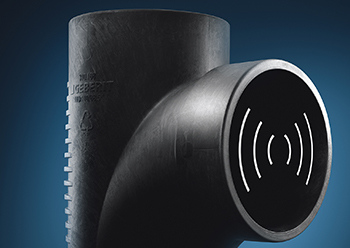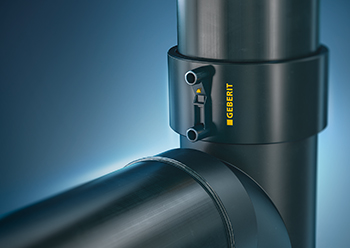Geberit HDPE tackles challenges
Switzerland-based Geberit says its high-density polyethylene drainage pipes provide optimum drainage solutions, thanks to their flexibility, durability, reliability, resistance to impact and abrasion and sound-dampening properties.
01 August 2020
Geberit, a leading European sanitary ware and fittings specialist, says its high-density polyethylene (HDPE) drainage pipes provide a total – and the most appropriate - solution for all types of drainage requirements, including above ground, below ground (within building footprint) and chemical waste, whether it is conventionally installed or prefabricated.
“Geberit HDPE represents the state of the art in drainage systems and is a real alternative to more traditional material installations,” Gabriel Nassar, Managing Director of Geberit’s Representative office Gulf, tells Gulf Construction. “It combines flexibility, durability and reliability complemented by environmental properties that put other pipe systems to shame.”
Geberit HDPE provides specifiers and installers with complete flexibility above and below ground. The properties of HDPE mean that these pipes and fittings are resistant to fracturing, abrasion, impact and extremes of temperature. Combined with the flexibility of several jointing methods and the option of off-site prefabrication, Geberit HDPE offers substantial material and labour savings, he adds.
Geberit HDPE’s discharge pipe combined with three fittings, namely the Sovent, BottomTurn Bend and BackFlip Bend, make up Geberit SuperTube technology that offers an ingenious hydraulic solution which is flow-optimised to create a continuous column of air in the discharge pipe, meaning a parallel ventilation pipe installation is no longer required. This apart, the innovative system helps save costs, and uses less pipes, and single stack smaller pipes 110 as opposed to 160.
 |
|
Geberit Silent-db20... outstanding acoustic insulation properties. |
Among other solutions offered by Geberit is Silent-db20, which offers all the benefits of HDPE – a material with inherent properties that provide many advantages over other traditional piping systems – with increased levels of sound proofing, which is achieved by its patented high-density material.
Geberit Silent-db20’s outstanding acoustic insulation properties are achieved by the patented high-density material it is made up of which was specifically developed for this purpose (PE-S2), while the ribbed fittings further boost sound dampening near impact zones. In addition, non-compressible rubber-lined acoustic brackets reduce the transfer of structure-borne noise by decoupling the stack from the structure. The complete range consists of pipes and fittings in dimensions from 56 mm to 160 mm, which guarantees complete acoustic insulation from the appliance connection through to the drainage system.
Apart from their improved acoustic properties, Geberit Silent-db20 pipes and fittings are compatible with the existing Geberit HDPE drainage system, enable time-saving installation due to the many different connection possibilities and feature a simplified fastening technique for use in commercial drainage systems. The bracketing system is optimised for the insulation of structure-borne sound.
“The density of polyethylene varies between 910 and 960 kg/cu m. Geberit HDPE systems are produced with HDPE with a density of up to 955 kg/cu m, which is of the highest quality and has excellent durability. This apart, Geberit Silent-db20 has a density of 1,700 kg/cu m, and its increased density improves its acoustic properties.
HDPE is light weight, which is beneficial particularly with regards to handling, transportation and installation.
To prevent shortening of dimension, Geberit HDPE is tempered 10 mm per metre (licence Geberit International).
Elaborating on why this is done, Nassar says: “The safest way of avoiding the inevitable reversion (shortening of the dimensions) after heat load in the plastic pipe is to take preventative measures during manufacture. Geberit HDPE pipes and Geberit Silent-db20 are, therefore, stored in hot water baths after manufacture. This process increases the safety of the joints, as there is no chance of joints pulling apart later due to shortening of length.”
Geberit HDPE pipes are protected against ageing and embrittlement caused by ultraviolet (UV) rays by the addition of approximately two per cent carbon.
The joint integrity of welded Geberit HDPE pipes is ensured, with the welding temperature for Geberit HDPE and Geberit Silent-db20 being approximately 230 deg C – relatively low in comparison with metals.
“Many years of experience with welding Geberit HDPE pipes have shown that butt welds do not give any problems as the welding parts are circular on the inside and do not add to the normal risk of blocking,” says Nassar.
Key properties
The flexibility of Geberit HDPE makes it ideal for certain buildings or on bridges, especially when pipes have to pass through expansion joints or are in buildings that are subject to traffic vibrations.
Geberit HDPE and Geberit Silent-db20 are poor conductors of heat, having a thermal conductivity 0.43 W/mK. For this reason, the pipe does not become completely warmed through when heat loaded for a short period. Heat loss is about 90 per cent less, for instance, than a similar copper pipe, he says.
Being poor conductors of heat, the pipes do risk formation of condensation during short periods of undercooling. For areas with longer periods of cooling in high humidity conditions, insulation may be required. In particular internal rainwater pipes passing through a warm building would benefit from thermal insulation.
Another key property of Geberit HDPE is its melt-flow index of 0.4 to 0.5 g/10 minutes. Melt-flow index describes the working properties of the pipe and provides information on the molecular weight, which is crucial for a number of raw material properties, explains Nassar. The smaller the melt-flow index, the higher the molecular weight and thus the pipe’s resistance to stress corrosion.
This apart, Geberit HDPE is resistant to radioactive effluents, hence there is no risk of damage as a result of slightly radioactive water. These pipes are also highly resistant to abrasion and their extra thick walls offer additional protection.
“Drainage systems are increasingly becoming hidden refuse chutes, hence a pipe’s resistance to abrasion is a particularly important factor in branch pipes, soil stacks and ground pipes,” Nassar points out.
In addition, Geberit HDPE and Geberit Silent-db20 pipes are resistant to impact being unbreakable at room temperature. Their resistance to impact is very high even at extremely low temperatures (down to approximately -40 deg C).
Also, because of their paraffinic structure, Geberit HPDE and Geberit Silent-db20 are highly resistant to chemicals. Geberit HDPE and Geberit Silent-db20 are insoluble in all inorganic and organic solutions at 20 deg C and are only soluble in aliphatic and aromatic carbons and their chlorinating products at over 90 deg C. The material will be attacked by heavily oxidised media when exposed over long periods at room temperature.
The thermal expansion of Geberit HDPE is relatively high 0.17 mm/mK. As a rule of thumb, for every 50 deg C increase in temperature, an expansion of 10 mm per linear metre of pipe can be anticipated.
Nassar points out that Geberit HDPE and Geberit Silent-db20 are not electrically conductive. “Plastics have an excellent reputation as insulators in the electrical industry, for example, HDPE cable protection ducts, cast resins and insulating paint,” he adds.
Geberit HDPE can be safely used as a waste pipe with continuous flow temperatures of up to 80 deg C and for intermittent discharges of up to 100 deg C for short periods (maximum one minute flow for a maximum of 400 times per year).
Being non-toxic, Geberit HDPE can be used in the food industry. “Geberit HDPE pipes are used for milk transportation lines in mountain areas and in the food canning and packaging industry,” he points out.
Geberit HDPE boasts water-repelling properties, which are highly beneficial in ensuring the rapid outflow of water and in the prevention of deposits. However, because of these properties and the flexibility of the material, these pipes are not suitable for painting.
Geberit drainage systems conform to: EN1519: Plastics piping systems for solid waste and discharge (low and high temperature) within the building structure – Polyethylene (PE); DIN 19535-10: High-density polyethylene (PE-HD) pipes and fittings for hot-water resistant waste and soil discharge systems (HT) inside buildings – Part 10: Fire behaviour, quality control and installation recommendations; and DIN EN 12666-1: Plastic piping systems for non-pressure underground drainage and sewerage systems – Polyethylene (PE).
- Geberit HDPE tackles challenges
- Weicon launches emergency repair kit
- Grooved couplings, the ‘future for the industry’
- Insight into corrosion cracking in pipelines



